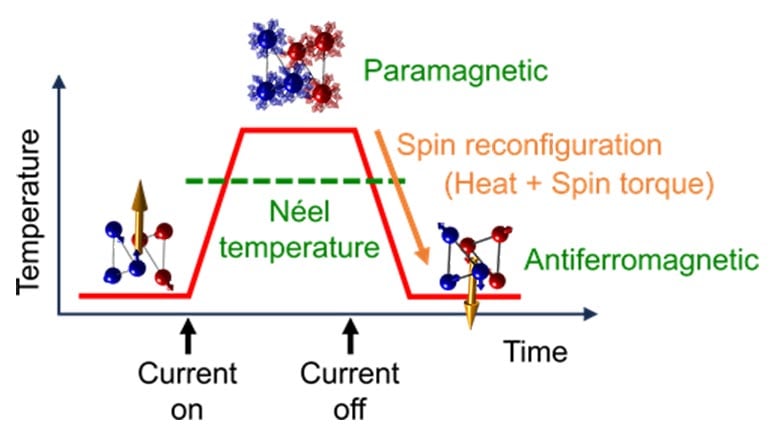

Researchers at the have developed a new experimental technique to measure heating effects in spintronic devices, enhancing our understanding of how heat influences magnetic behavior.
This discovery could pave the way for selecting materials that maintain high functionality with minimal heating, thereby optimizing spintronics for energy efficiency and speed.
Spintronics – devices that use microscopic magnetism in conjunction with electric current – could lead to computing technology as fast as conventional electronics but much more energy efficient. As such devices are developed and studied, an important unresolved question is how device operation is affected by heating.
Innovative Measurement Techniques in Spintronics
A new experimental technique, reported by researchers at the University of Illinois Urbana-Champaign in the journal APL Materials, directly measures heating in spintronic devices, allowing direct comparison to other effects. The researchers say that this technique can be used to select spintronic materials whose magnetic behavior is minimally impacted by heating, leading to faster devices.
“Spintronic devices depend on the ability to change magnetization using electric currents, but there are two possible explanations for it: electromagnetic interactions with the current, or the increase in temperature caused by the current,” said Axel Hoffmann, project lead and Illinois materials science & engineering professor. “If you want to optimize the function of the device, you have to understand the underlying physics. That’s what our approach helped us to do.”

The Promise of Spintronics Over Traditional Electronics
Unlike electronics, which use electrical signals to store information and perform calculations, spintronics exploit a fundamental property of electrons called spin that results in microscopic magnetic behavior. These devices have the potential to use far less energy than their electronic counterparts, owing to the magnetic nature of their operation. It has even been suggested that spintronics controlled by fast electronics would remain energy efficient while matching the speed of conventional computers. “It’s like getting the best of both worlds,” according to Hoffmann.
The challenge has been finding materials suitable for such devices. Antiferromagnets have attracted attention for their periodic arrangements of opposite spins and their limited sensitivity to neighboring devices. To use these materials for memory and computing, the spin structure must be controlled with electric current. The currents required to do this are so large that device temperatures rise to the point where thermal effects impact spin structure in addition to electromagnetic effects.
Differentiating Effects of Current and Temperature
“There’s an ongoing debate whether the current is directly responsible for spin changes or if it’s the resulting heating that has the dominant effect,” Hoffmann said. “If it’s a current-driven effect, it’s very simple to make the effect very fast. If it’s a thermal driven effect, then thermal conductance and thermal relaxation are important, and they may limit how fast you can operate the device. So, the exact functionality of the device depends on what physics is responsible.”
Past efforts to clarify the importance of current- and temperature-driven effects were hindered by the inability to directly measure heating effects in small-scale devices. Myoung-Woo Yoo, a postdoctoral researcher in Hoffmann’s group, demonstrated an experimental method in which thermal effects are deduced from how a device heats substrates with different thermal conductivities.
“We prepared antiferromagnetic samples on silicon dioxide substrates with different thicknesses,” Yoo said. “The substrate’s ability to conduct heat goes down with increasing thickness, meaning that antiferromagnets on thicker samples have higher temperatures when the same electric current is applied. If device heating is important for the spin structure changes, then there will be a difference across devices on different substrates.”
Conclusion and Future Applications
The researchers found that heating had a significant effect in the antiferromagnet that they studied, Mn3Sn. However, they noted that there are many other antiferromagnets under consideration for spintronics, and this technique provides a framework to systematically compare the role of heating to that of electric current effects.
“We now have a well laid out strategy to assess the influence of electric heating in spintronics devices,” Yoo said. “In addition, it’s very easy to do in very general terms, so it can be applied to any system, including standard electronics. This methodology can be used to optimize the functionality in any kind of microscopic device.”
Reference: “Thermal contribution to current-driven antiferromagnetic-order switching Editor’s Pick” by Myoung-Woo Yoo, Virginia O. Lorenz, Axel Hoffmann and David G. Cahill, 14 August 2024, APL Materials.
DOI: 10.1063/5.0219729
Illinois materials science & engineering professor David Cahill and Illinois physics professor Virginia Lorenz also contributed to this work.
All contributors are affiliated with the Materials Research Laboratory at Illinois.
This work was supported by the National Science Foundation through the Illinois Materials Research Science and Engineering Center.

